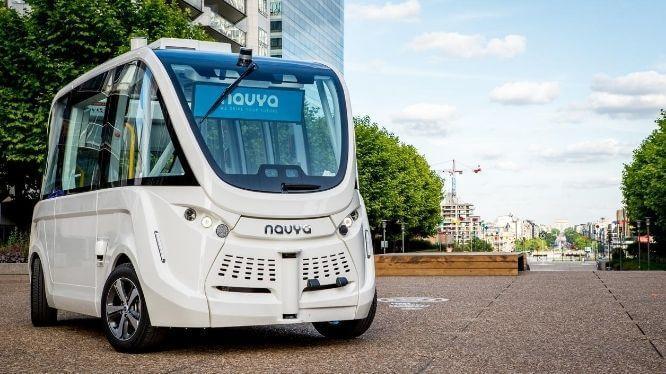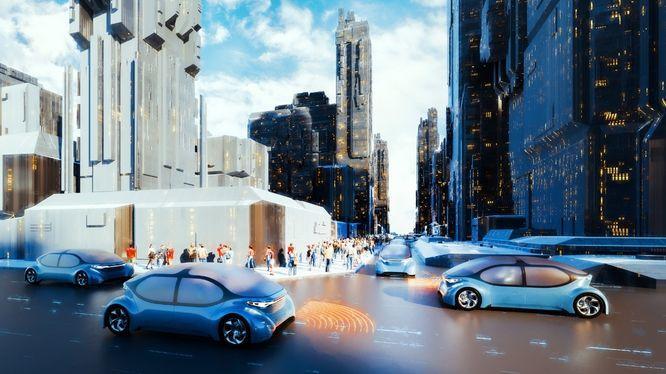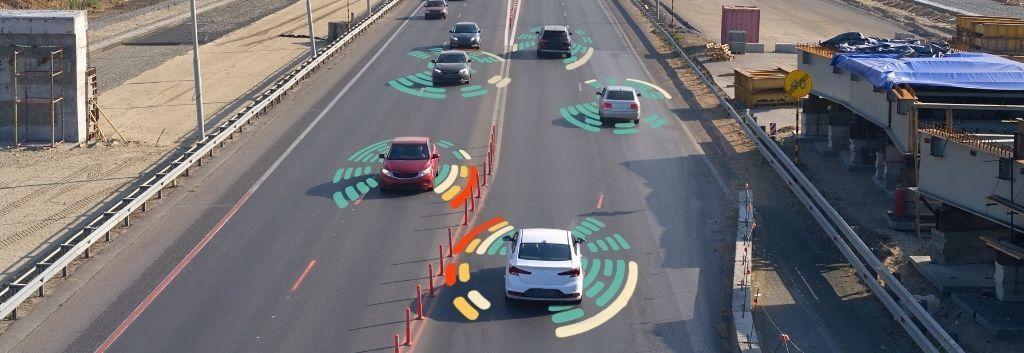
The use of advanced autonomous driving technologies, such as autonomous driving Level 3 in commercial vehicles and Level 4 in public transportation, is about to begin in earnest. autonomous driving An era is dawning, an era in which autonomous driving will be experienced in many different places.
In this column, we will explain the definition of each autonomous driving level, as well as the latest development and practical status. The levels are based on the standards established by the Society of Automotive Engineers (SAE) of the United States, which is the most widely used in Japan and around the world.
autonomous driving level overview
The SAE has set standards for autonomous driving levels, which are divided into six levels, from 0 to 5. Each level defines the "control subject" and "driving area," and these are treated as the standards for the most mainstream autonomous driving levels.
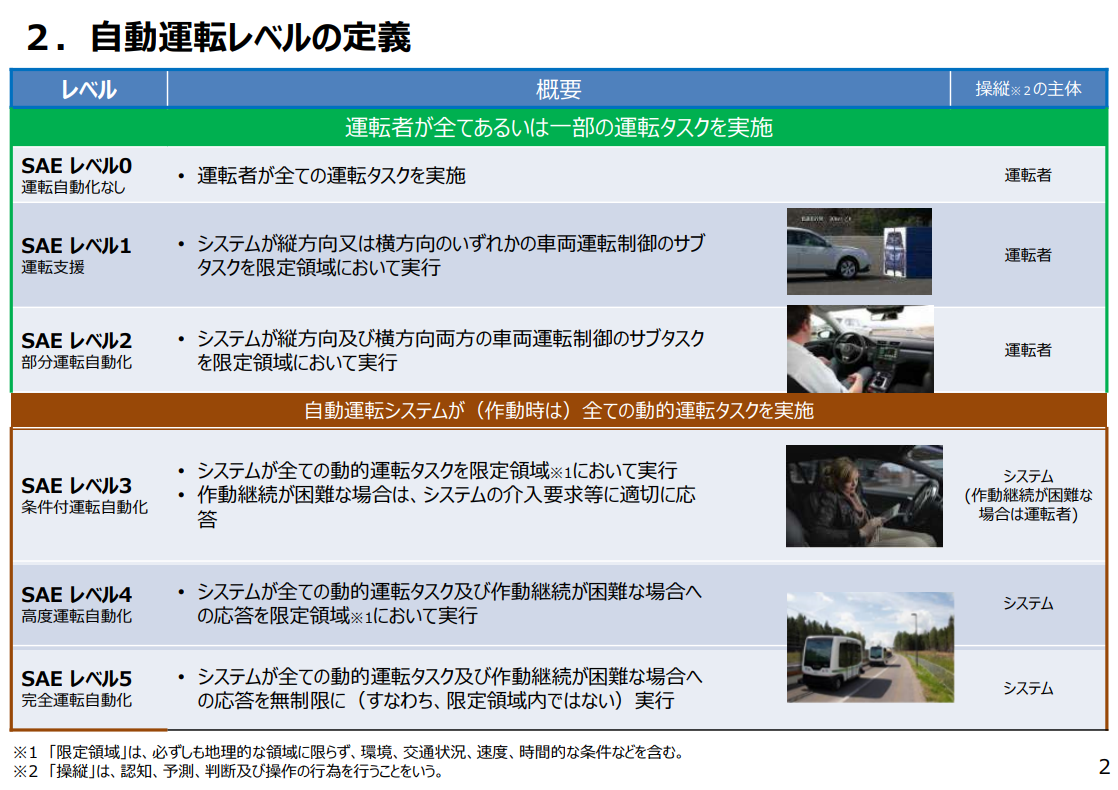
Source: National initiatives and prospects for promoting autonomous driving transportation services (Ministry of Economy, Trade and Industry)
The Ministry of Land, Infrastructure, Transport and Tourism has also announced levels of autonomous driving based on the standards defined by the SAE. In all autonomous driving levels, the dividing line is between level 2 and level 3, where the main driver is either a "human" or a "system."
Levels 1 and 2 are classified as advanced driver assistance systems (ADAS), and while the human remains the primary driver, some driving assistance functions have been added. However, from level 3 onwards, the system takes over control, and the human is able to do things other than driving while driving. Actions other than driving are called "second tasks," and it is easy to imagine that the ability to do second tasks will dramatically change the way we spend time inside the car.
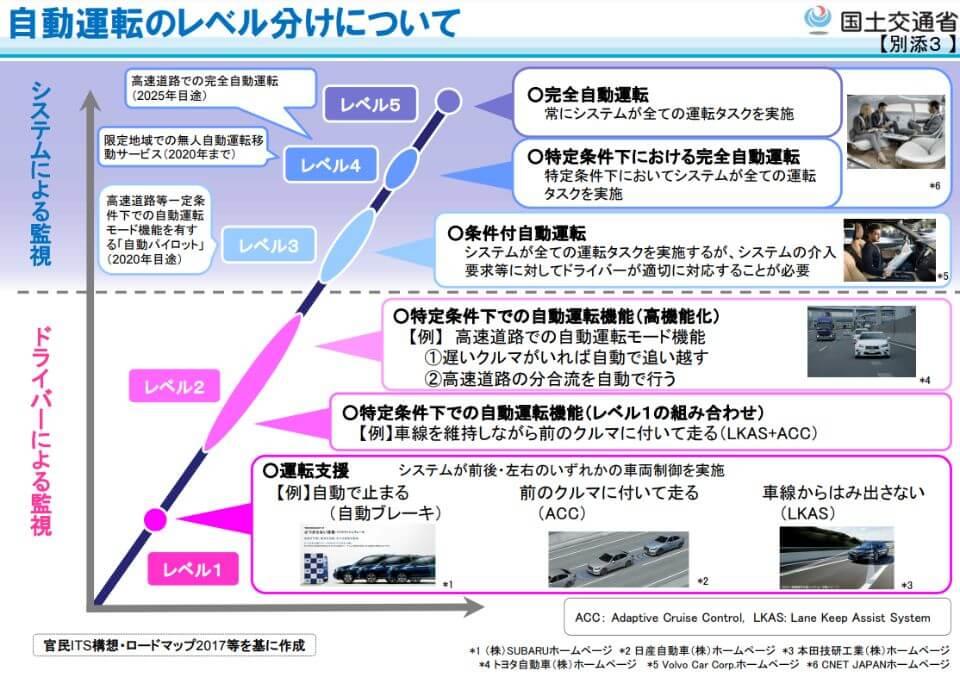
Regarding the classification of autonomous driving levels (Source: Ministry of Land, Infrastructure, Transport and Tourism "Regarding the classification of autonomous driving levels")
Autonomous autonomous driving level 0-1: Conventional car
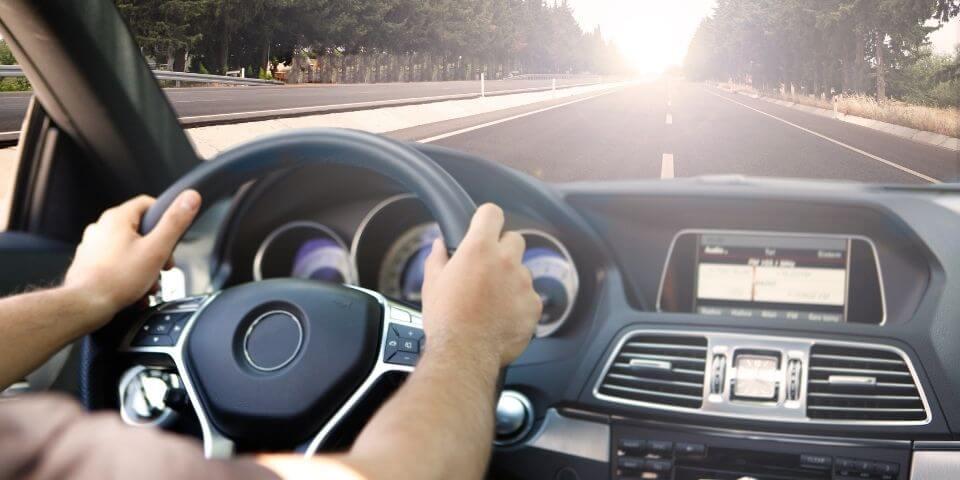
Level 0 autonomous driving refers to "no driving automation," in which the driver is responsible for all driving tasks. This applies to conventional cars that are not equipped with ADAS.
Level 1 autonomous driving refers to "driving assistance," where the system executes subtasks to control either longitudinal or lateral vehicle movement in a limited area (under set conditions). For example, this includes systems equipped with either acceleration/deceleration or steering assistance functions, such as "adaptive cruise control" that can follow the vehicle ahead, or "lane keep assist system" that keeps the vehicle within its lane. Level 1 also includes a "collision mitigation brake" function, commonly known as "automatic braking," which automatically activates the brakes when there is an obstacle in front of the vehicle.
Due to a change in the law in November 2021, all new domestically produced vehicles are required to be equipped with automatic brakes. Domestically produced vehicles (other than light trucks) released before November 2021 will be required to be equipped with automatic brakes from December 2025, and light trucks from September 2027. For imported vehicles, new models will be required to be equipped with automatic brakes from July 2024, and continued production vehicles will be required to be equipped from July 2026. *1
Therefore, Level 0 will be the only vehicles on the market, and "autonomous driving" cars will gradually disappear.
*1: The automatic braking system is only a system imposed on manufacturers who sell new cars, and does not impose penalties on drivers. There is no obligation to apply this system to existing or used cars, so there is no need to buy a new car.
Autonomous autonomous driving level 2: Hands-off is possible
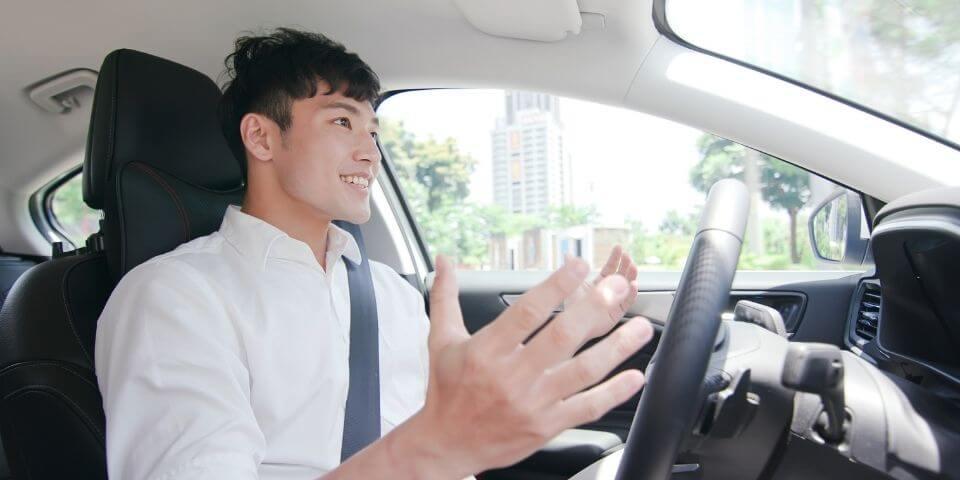
Level 2 autonomous driving refers to "partial driving automation," in which the system controls both longitudinal and lateral vehicle motion in a limited area. This type of system is equipped with both the aforementioned "adaptive cruise control" and "lane keep assist system," and assists with acceleration/deceleration and steering. This function allows the vehicle to follow the vehicle ahead while maintaining its lane in a limited area.
When this level 2 becomes more advanced, it will lead to a system that allows hands-off driving. As before, it is necessary to be aware of the surrounding situation while driving, but you can take your hands off the steering wheel when certain conditions are met, such as on a highway with no people, intersections, or traffic lights. In 2019, Nissan was the first in Japan to announce the "ProPILOT2.0" equipped with a hands-off function. Following that, Toyota and Lexus' "Lexus Teammate" and Subaru's "Levorg" were also announced with hands-off functions. As of October 2024, almost all domestic manufacturers have level 2 vehicles including hands-off functions. In the future, new cars released will undoubtedly be equipped with advanced level 2 systems.
In addition, technologies essential for autonomous driving such as "high-precision 3D maps," "LiDAR," and "driver monitoring systems," are moving toward full-scale practical use with the advancement of Level 2.
autonomous driving level 2 vehicles available in Japan
There are currently many Level 2 autonomous driving vehicles on the market for sale in Japan. Here we will introduce some representative Level 2 models from Japanese automakers.
|
Maker |
car model |
| Toyota | Mirai, Lexus LS, Alphard, Prius, etc. |
| Nissan | Skyline, Aria, Serena, Sakura, etc. |
| Honda | Z-RV, Vezel, N-BOX, etc. |
| Subaru | WRX S4, Legacy Outback |
| mazda | CX-60, MAZDA6, etc. |
| mitsubishi | Outlander PHEV, ekcross, etc. |
| Daihatsu | Tanto, Taft, Rocky, etc. |
| Suzuki | Wagon RSmile, Hustler, etc. |
Autonomous autonomous driving level 3: Eyes off possible

Level 3 refers to "conditional driving automation," in which the system performs all dynamic driving tasks under limited conditions. For example, when the driver is stuck in a traffic jam on the highway and takes their hands off the wheel and their eyes off the road, the system still performs all driving tasks. Although this is under limited conditions, at level 3 the control of the vehicle switches from "human" to "system." However, if the system has difficulty operating under limited conditions, the driver must respond to the system's request for intervention. To explain using a specific example, this would apply when getting off the highway or when the traffic jam is cleared.
Level 3 is often called "eyes-off", which allows you to take your eyes off the driving situation, as opposed to "hands-off" at altitude level 2.
autonomous driving level 3 vehicles available in Japan
Currently, the only commercially available car with Level 3 autonomous driving made in Japan is the Honda Legend equipped with Honda SENSING. The Legend is the world's first commercially available car equipped with a Level 3 autonomous driving system. However, production of the Legend ended in January 2022. Since then, no Level 3-compatible commercially available cars have been released in Japan.
Even overseas, there are almost no commercially available cars equipped with Level 3 systems. The only ones that are compatible are the Mercedes-Benz S-Class and the EQS EV for the U.S. market.
The DRIVE PILOT system installed in Mercedes-Benz's Level 3 vehicles is a driving assistance system that has been type-certified by the SAE and only operates under conditions of speeds of 40 miles per hour (about 64 km) or less on high-traffic sections such as highways.
Domestic driving conditions for Level 3 autonomous driving
In Japan, the "Amended Road Traffic Act" and the "Amended Road Transport Vehicle Act" came into force in April 2020. "Automated driving devices" are now officially defined under the law, making Level 3 driving possible. Under certain operating environments, drivers are freed from the obligation to monitor the area around the vehicle. However, they must be able to immediately return to driving when requested by the system.
The following safety standards are required:
- Equipped with an operating status recording device
- Driver monitoring function that monitors the driver's condition
- Cybersecurity measures to prevent unauthorized access
- Minimum Risk Maneuver feature that safely stops the vehicle if the driver does not respond to a request to take over driving operations
- A sticker indicating that the vehicle is autonomous driving vehicle will be attached
Additionally, the specification standards for low-speed automated driving devices stipulate that autonomous driving system must operate at speeds of 60km/h or less, and that the system must remain within the driving lane. In other words, for the time being, autonomous driving will only be activated during traffic jams on expressways and other motor-vehicle-only roads. This may seem impractical, but the international standards are of the same nature, and it is expected that systems will be gradually expanded after first being implemented in society under safe driving conditions and the accuracy of each developer's system has been verified.
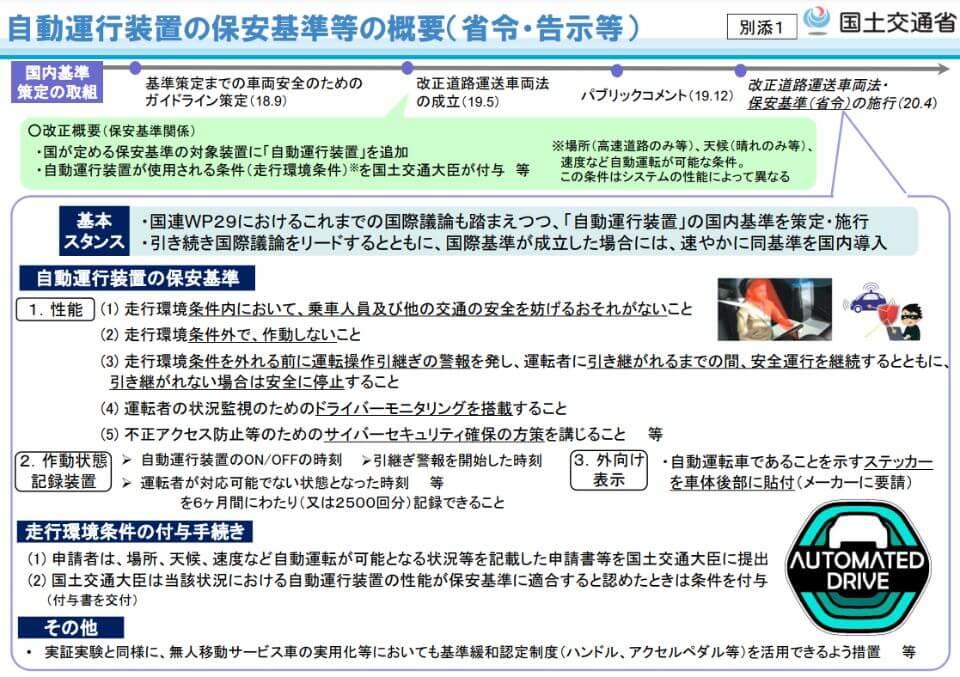
Safety standards for automated driving devices (Source: Ministry of Land, Infrastructure, Transport and Tourism "We have established safety standards for autonomous driving vehicles!")
autonomous driving level 4: A level where unmanned driving is possible

Level 4 autonomous driving refers to "highly automated driving," in which the system takes over all driving tasks in the Operational Design Domain (ODD) and responds when it is difficult to continue operating. In other words, it enables "driverless driving."
With the revision of the Road Traffic Act in April 2023, Level 4 vehicles will finally be allowed to be driven on public roads in certain areas in Japan. The system must meet certain conditions set out by law, such as obtaining permission from the prefectural public safety commission and having the ability to stop the system quickly and safely if a malfunction occurs in the autonomous driving system.
This legal amendment assumes autonomous driving (for buses, etc.) in limited areas such as depopulated areas with few people or within specific facilities, and it is still difficult to apply it to commercially available cars that run freely on public roads. Further progress is needed to improve the capabilities of autonomous driving vehicles themselves and to improve the legal aspects.
Additionally, it is essential to adopt a Fleet Management System (FMS) that remotely monitors autonomous driving vehicles. It is necessary to have a system in place that monitors vehicles in real time and allows for remote control and intervention in the event of an emergency such as an accident or other problem. Creating an environment in which information obtained from the vehicle can be reliably transmitted to a remote control room is important to achieving Level 4.
autonomous driving level 4 vehicles available in Japan and the status of demonstration experiments
According to the "Public-Private ITS Initiative and Roadmap" formulated by the government, it aims to realize driverless autonomous driving services nationwide after 2025, but currently there are no commercially available vehicles with Level 4 autonomous driving on sale either domestically or overseas. Although there are no news of plans to release one in Japan, China's Baidu has announced that it will release an EV equipped with Level 4 autonomous driving in 2022. The launch was scheduled for 2023, but as of July 2024 it has yet to be released.
For commercially available vehicles, after realizing Level 3, it is expected that Level 4, which will enable autonomous driving from the entrance to the exit of a highway, will be commercialized after 2025. In 2024, demonstration experiments toward the realization of this vision are steadily progressing, including the start of implementation of support measures such as the installation of lanes exclusively for autonomous driving vehicles during late-night hours on the highway (Shin-Tomei Expressway Suruga Bay Numazu SA - Hamamatsu SA).
Logistics services such as trucks are also aiming to implement delivery services using autonomous driving in limited areas from 2025 onwards.
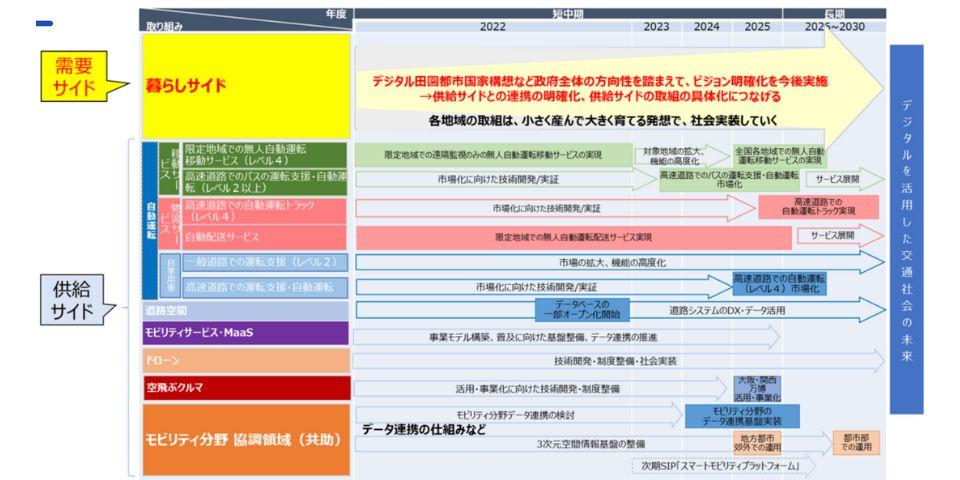
Source: Public-Private ITS Concept and Roadmap (IT Strategic Headquarters)
On the other hand, there are places where level 4 autonomous driving transportation services have been realized. In May 2023, Eiheiji Town in Fukui Prefecture launched the first autonomous driving level 4 public transportation service on Japanese public roads, running along a set route on a roughly 2km promenade.
There are already cases overseas where commercial taxis are operating in city areas.
autonomous driving Level 5: To Fully autonomous driving
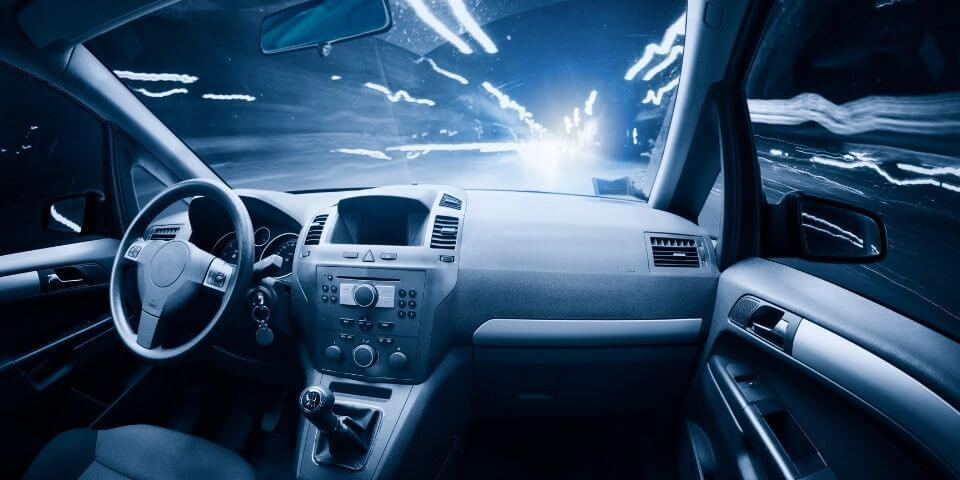
Level 5 refers to "full driving automation," where the system takes on all driving tasks without the setting of an ODD (Operational Design Domain)*2. This refers to "full autonomous driving by an autonomous driving system in any location and under any circumstances." The idea is that the system will drive on any road, from city streets to mountain roads, even on thunderstorms and snowy days. The roadmap drawn up by the government has not yet made clear when Level 5 autonomous driving will be realized. This is true not only in Japan, but also around the world except for Europe.
It is said to be difficult to achieve with current technology, but hopefully with the evolution of various sensors and AI, and the development of new methods, the day will come when this becomes a reality.
*2: ODD stands for Operational Design Domain, and refers to the driving environment conditions for the operation of the autonomous driving system. autonomous driving system operates normally only when the conditions designed into the system are met. Therefore, if any condition is not met, operation will be suspended or human intervention will be required.
Currently, demonstration experiment status of autonomous driving level 5
As mentioned above, there are currently no vehicles equipped with Level 5 autonomous driving, and the public and private sectors are working together to explore the possibility of making it a reality. One of the initiatives is a plan to conduct a demonstration experiment at the International Horticultural Exposition (Floral Expo) to be held in 2027.
The event will take place in Yokohama for around six months and is expected to be the first of its kind in Japan as the government has publicly announced plans for a demonstration experiment.
Regarding Level 5, there are no clear plans for demonstration experiments either domestically or overseas, but the technology is still being explored.
Summary: autonomous driving enters a new phase
With the social implementation of Level 3 and Level 4, the autonomous driving industry is making further progress, with the growth of various markets such as sensors, the spread of connected cars, and the development of new services. Of particular interest is the field of services that utilize Level 4. From the perspective of how to implement Level 4 in society, which has great potential as a solution to social issues and as a new business, it will be a great opportunity not only in terms of technology but also in terms of services such as MaaS (Mobility as a Service). Taxis equipped with Level 4 have already appeared in China and the United States, and some places are operating without drivers.
With the advancement of Level 4 technology, the autonomous driving industry is entering a new phase, so it will be important to continue to pay close attention to trends.
Inquiry
the Company, Macnica, provides a variety of products and services related to autonomous driving. If you have any questions or requests regarding autonomous driving, please feel free to contact us below.


